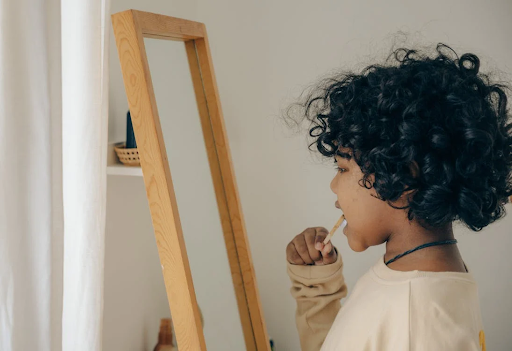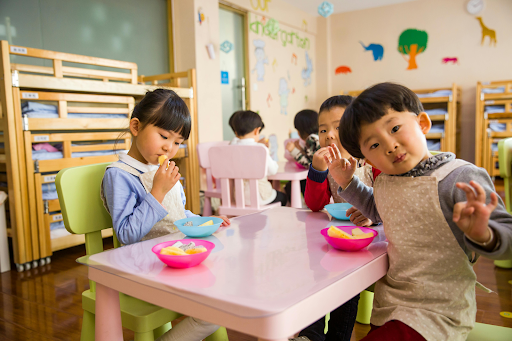
A preschooler’s daily schedule is very crucial since it provides a healthy environment for growth. A well-structured schedule offers predictable patterns that help children display social, emotional, and cognitive development. Such a routine teaches children time management skills, encourages them to be independent, and allows a good mix of learning, play, and rest. A daily schedule reduces anxiety and makes the child feel secure, thereby being confident and promoting overall well-being.
Benefits of a Daily Schedule for Preschoolers
Promotes Stability and Security
A consistent routine makes a preschooler feel secure and self-assured because it gives their day some form of structure and predictability. If things are familiar to a child, then feelings of uncertainty and anxiety will be reduced, thereby making their daily activities less challenging. This stability of routine frees them to roam about and discover the environment because they can be comfortable knowing that their basic requirements are satisfied.
Supports Developmental Milestones
Routine activities strongly support cognitive, social, and emotional development. Scheduled activities, such as reading time, group play, and arts and crafts, promote learning and appropriate social behavior. In addition, structured periods offer a context for children’s emotional growth because they begin to anticipate transitions in their day and find ways to manage feelings.
Encourages Independence
A daily routine encourages independence in young children as it can guide them toward understanding time management and responsibility. Children can begin to manage their activities, like getting ready by themselves or cleaning up after playing. This helps them feel a little more self-reliant and trust themselves to carry out everyday tasks.
Balances Play and Learning
Balancing playtime, learning, and rest is essential in a preschooler’s day. Playtime, whether structured or free, is vital for creativity and physical development. Learning activities stimulate cognitive growth, while regular rest periods, including naps, ensure that children are well-rested and able to engage fully in their activities. This balance helps children develop holistically, ensuring they grow into well-rounded individuals.
Key Components of a Preschool’s Daily Schedule
Morning Routine

A planned morning routine is what will determine the pulse of the rest of the day. Create a daily wake-up routine to set up an internal clock for your preschooler. Then, there’s breakfast – it should be tasty but also healthy, as it will power their body and mind. Naturally, the morning routine must involve getting dressed, brushing teeth, and other hygiene activities. Once a child knows what their morning routine includes, they can conquer the day.
Learning Time
Learning time is a crucial part of the day for preschoolers. Allocate a certain time slot to educational activities, such as reading, arts and crafts, and educational games. These activities would certainly interest your child and promote cognitive abilities. For instance, read to your child for 20 minutes and spend an additional 30 minutes with them in creative arts so they can express themselves and learn new things. Breaking the duration of learning into manageable segments keeps preschoolers interested without overwhelming them.
Playtime
Playtime is crucial for preschoolers’ integral development. That is, balanced by structured play and free play. Structured play includes games or activities with set rules so that children learn about boundaries and cooperation. Free play, on the other hand, is essential so that children can freely exercise their imagination and creativity. A balance of indoor and outdoor play is advised to give a child a wide range of environments to get physical activity and explore. Whether building with blocks inside or running around the backyard, playtime develops their body, maintains social relationships, and ensures positive emotional growth.
Snack and Lunch Breaks

Preschool children require snack time and lunch breaks to maintain energy levels throughout the day. Proper snacks given on time close the gaps between meals, avoiding dips in energy that can lead to irritability or lack of focus. A balanced lunch will definitely fuel the system for their fun activities and learning in the afternoon. Offering a variety of healthy options, like fruits, vegetables, whole grains, and proteins, ensures that your child gets the fuel they need to keep them going and stay active.
Nap Time
Napping plays an essential role in the life of a preschooler, as this activity helps them improve physiologically as well as mentally. Generally, the perfect nap time for a preschooler is 1 to 2 hours. Such long naps refresh preschoolers, making their moods and attention span better, besides their behaviour. Proper rest also promotes cognitive processes, including memory consolidation and problem-solving skills. Naps should be included in their daily schedule so that preschoolers feel refreshed and ready to carry out the rest of the day with vigour.
Afternoon Activities
Afternoon activities should be calm yet engaging, helping children transition smoothly from nap time. Quiet time activities like reading or drawing can gently reawaken their minds without overwhelming them. Puzzles and simple chores, such as tidying up toys or helping set the table, promote cognitive development and a sense of responsibility. These activities can be both relaxing and stimulating, offering a balanced approach to post-nap engagement.
Evening Routine
The evening routine is an important part of winding down the day, preparing preschoolers for a restful night’s sleep. Begin with a healthy dinner that includes a variety of food groups to ensure balanced nutrition. Following dinner, a bath can help relax your child, signalling that it’s almost time for bed. Finally, bedtime stories provide a comforting end to the day, fostering a love for reading while offering a sense of security and routine.
Role of Preschool Visual Schedule
A preschool visual schedule is a powerful tool that uses images to represent the daily activities and routines of young children. These visual aids help preschoolers know what to expect as the day unfolds, thus making it easier for them to transition between activities. For instance, if the child sees pictures of waking up, eating breakfast, playing outside, and then kindergarten time, they will be better prepared, emotionally and psychologically, to face the rest of the day.
Another good application of visual schedules is for students who are young or non-readers or have inadequate comprehension of independent oral instructions. It can give these students a very concrete, easy-to-understand representation, about what the day will be like, thus reducing confusion and anxiety. For example, a picture of a book may represent reading time or an image of a playground may indicate outdoor play.
With a visual schedule, children learn to navigate independently because they can look at the schedule, and it shows them what is coming next. This gives them a lot of power and helps build their confidence. Visual schedules can also be highly individualized; one can use them for a variety of children because of the easiness with which they can be altered to meet each child’s requirements, a welcome tool for both teachers and parents.
Customizing a Preschool Schedule for Your Child
Understanding Your Child’s Needs
The foremost thing to be determined about building a tailored daily routine is to determine your child’s needs. Every child differs, with unique preferences, energy levels, and interests. Observe the natural rhythms of your child: do they tend to be more energetic in the morning or following a nap? Do they have particular times of the day when they are more receptive to learning or need more rest? Use these insights to structure activities accordingly. For instance, if your child is more focused in the morning, you might schedule educational activities like reading or arts and crafts during that time, reserving the afternoon for free play or quieter tasks.
Flexibility and Adjustments
The critical thing when building the schedule is flexibility and though consistency is good, flexibility is equally as important. Children can be unpredictable, and their needs may change from day to day. Prepare for this as you make a schedule; sometimes, allow for more playtime when they seem engrossed or shorten learning sessions if they seem overwhelmed. Flexibility also means being responsive to unexpected events or disruptions without causing stress for you or your child. By keeping the schedule adaptable, you create a more relaxed and positive environment that caters to your child’s evolving needs.
Sample Preschool Schedule
Here is a sample daily schedule to help you structure your preschooler’s day:
7:00 AM – Wake-Up Time:
Start the day with a consistent wake-up time. Follow up with hygiene activities such as brushing teeth and getting dressed.
7:30 AM – Breakfast:
Offer a nutritious breakfast to fuel your child’s energy for the morning.
8:00 AM – Learning Time:
Engage in educational activities like reading or arts and crafts. Aim for interactive sessions to keep your child interested.
9:30 AM – Morning Snack:
Provide a healthy snack to maintain energy levels.
10:00 AM – Playtime:
Mix structured play (like building blocks) with free play, allowing for creativity and physical activity.
11:30 AM – Lunch:
Serve a balanced meal, including a variety of food groups.
12:00 PM – Nap Time:
Encourage a nap lasting 1 to 2 hours to help your child recharge.
2:00 PM – Quiet Activities:
Post-nap, engage in calm activities like puzzles or quiet reading.
3:00 PM – Afternoon Snack:
Another nutritious snack to keep energy levels up.
3:30 PM – Outdoor Play:
Allow time for outdoor activities like running or playing at the park.
5:00 PM – Evening Routine:
Start with dinner, followed by a bath, and finish with bedtime stories around 7:30 PM.
Adjust this sample as needed to best suit your child’s unique rhythms and your family’s lifestyle.
Tips for Implementing a Schedule For Preschoolers
Consistency is Key
A preschooler needs consistency in his or her routine; however, it’s always good to strike a balance between being consistent and overly rigid. Find consistent times for major events like meals, naps, and play, but not too tight that nothing varies in these routines. In this way, children learn to expect what is to come next but have some freedom. In case you feel your child has been excessively tired one specific day, it is perfectly fine to adjust the schedule so that they get some extra rest. The bottom line is that you maintain a general structure but, at the same time, must also be responsive to the immediate needs of your child.
Involve Your Child
Involving your preschooler in planning their day can make the schedule more meaningful and engaging for them. Give them simple choices within the routine, such as picking between two books for story time or choosing a snack from a few healthy options. You can also use a visual schedule to help them understand the plan for the day, allowing them to move markers or pictures as activities are completed. This involvement fosters a sense of ownership and excitement about their daily activities.
Keep it Fun and Engaging
To make the routine enjoyable, incorporate activities that your child loves and vary them to keep things fresh. Use playful approaches to transition between activities, like singing a clean-up song before moving on to the next task. Engage your child with themes or special days, such as “Crafty Wednesdays” or “Outdoor Adventure Fridays.” Incorporate their interests into the schedule, whether it’s dinosaurs, princesses, or outer space, to make learning and daily routines feel like an adventure. Keeping the routine fun ensures that your child looks forward to each part of their day, fostering a positive attitude towards structured activities.
Conclusion
A balanced daily schedule is vital for fostering stability, development, and independence in preschoolers. By incorporating structured routines, children benefit from cognitive, social, and emotional growth while enjoying a healthy mix of learning, play, and rest. Remember, the best schedule is one that fits your child’s unique needs and your family’s lifestyle. Stay flexible and open to adjustments, ensuring the routine remains enjoyable and supportive for your child’s development.
FAQs
1. What is an ideal daily schedule for preschoolers?
An ideal daily schedule for preschoolers includes a mix of learning activities, playtime, meals, naps, and a consistent bedtime routine.
2. How much sleep does a preschooler need?
Preschoolers typically need 10-12 hours of sleep in a 24-hour period, including naps.
3. How do I balance play and learning in my child’s schedule?
Balance play and learning by integrating educational games, arts and crafts, and interactive reading sessions into the day, ensuring that there’s also ample time for free play.
4. Is it important to include outdoor playtime in a preschooler’s schedule?
Outdoor playtime is crucial as it promotes physical activity, social skills, and exploration.
5. How do I handle disruptions in my preschooler’s daily routine?
Handle disruptions by staying flexible and reassuring your child, gradually guiding them back to the routine.
6. What time should a preschooler go to bed?
A consistent bedtime, ideally between 7:00 PM and 8:00 PM, ensures they get enough rest.

